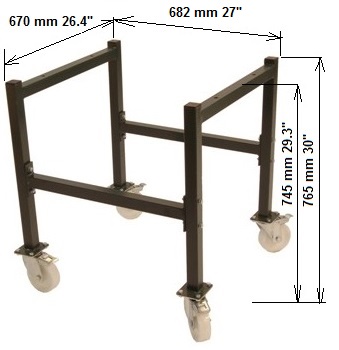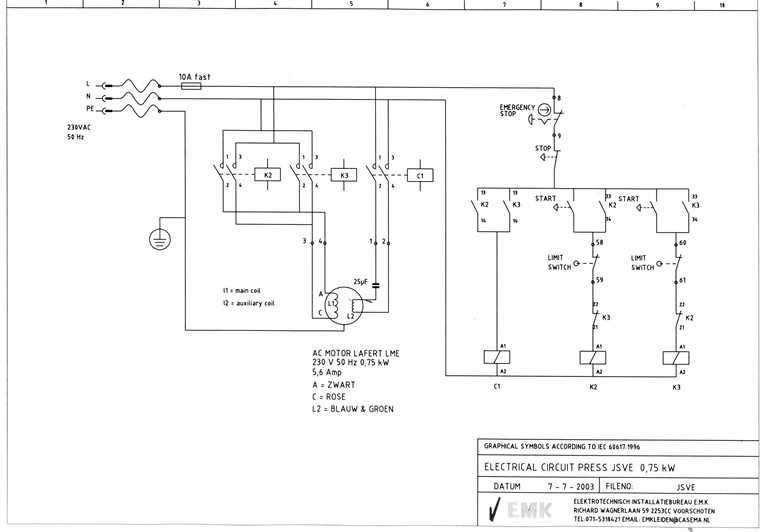|

|
Technical data etching press JSVE-60 |
|
|
Plate format (bed size) |
60 x 120cm |
24x47" |
Diameter of upper roller |
12,5 cm |
5" |
|
Thickness of bed |
1 of 1,5 cm |
0.4 or 0.6" |
Wall thickness upper roller |
1,7 cm |
0.7" |
|
Measurements of the press |
Diameter of lower solid roller |
9 cm |
3.5" |
|
- Length (of side frames) |
59 cm |
23" |
Work height on stand |
86 cm |
34" |
|
- Width |
96 cm |
38" |
Thickness of steel side frames |
2 cm |
0.8" |
|
- Height without stand
- Height including stand |
40 cm
114 cm |
16"
45" |
Max. opening between bed and upper roller |
4 cm |
1.6" |
|
Length of roller |
60 cm |
24" |
Spindles screw thread |
M 16 |
|
Weight of the press |
120 kg |
260 lbs |
Stand dimensions Optional |
HxWxL
77x68x67cm |
HxWxL
30x26x26" |
|
Work height without stand |
23 cm |
9" |
Electric voltage AC
optional |
230 Volt
120 Volt |
|
Power electric motor |
750 Watt |
Motor speed |
1400 R.P.M |
|
Total gearing ratio |
1 : 256 |
Printing speed |
2,3 cm/sec
1"/second | General
The plate material; "printing bed":
The plate is made of laminated paper sheets, in liquid resin, pressed under high pressure and temperature. The plate is covered, on both sides, with a white melamine coating. Perfect bed material, compared with a metal bed; does not warp, no oxidation, cheap, safe (=not heavy), very pressure resistant, easy to make marks on the bed.
Top roller driven or bottom roller driven:
Regularly printmakers ask us which drive system is better. There is no difference, the paper does not "feel" the difference while being printed. Some believe that top roller driven is better, some believe bottom roller driven is better. We have both systems available. |
The JSVE series has a drive system with an electric motor, driven on the lower roller. The gear-wheels are protected with a steel cover. The hard synthetic plate runs between adjustable guide strips, mounted on the solid steel frames.
The pressure springs are found under the upper roller. If the spindles are loosened the upper roller is raised by spring pressure. This results in a space appearing between the upper roller and the bed, thus facilitating the sliding of the printing sandwich. This feature makes this press also very suitable for lino and woodcut printing.
Shims of leather or card board can be placed under the spindles thus providing more flexibility during printing (useful when printing woodcuts, to compensate a little bit the irregularities in the wood).The basic design of these electric presses is taken from the JSV-series, with the following changes and features;
- driven by electric motor, 230 V, 0,75 kW, single speed. An electric motor for 110 V can be supplied.
- control panel features, left, right and a highlighted stop button.
- safety guard on both sides of the upper roller, keeps fingers away from roller. This safety guard is made of a small plastic roller, over the width of the bed. This roller rests on the bed and will lift when necessary for the passage of the plate and paper.
- motor automatically shuts off at both ends of bed (micro-switches).
These presses can be delivered with two sorts of under frames; with or without casters. The frames are detachable and made of steel tubes. De casters have breaks, wheels of nylon 5" diameter which makes moving the press easy. The under frames can be fitted with a shelf.
|

|

|
|
Etching press JSVE-60 with a simple under frame JSO-60
Click here for larger image |
Etching press JSVE-60 engine side and worm gear side. Fitted with a simple under frame with a shelf.
Click here for larger image |
|

|

|
|
Like the JSV-60 (above) the electric press JSVE-60 can be fitted with an under frame on casters; the JSOW-60
Click here for larger image |
Dimensions of the under frame JSOW-60. The dimensions of the under frame JSO-60 (without casters) are identical. The underframe is detachable. |
|

|
|
|
1 |
Pressure spindles M16 |
|
2 |
Plastic protection rollers. These rollers can be lifted, to allow the blanket, forme and paper under the top rolller. This system protects the hands of the printmakers. |
|
3 |
The press bed. Micro switches are fitted under the bed to stop the bed at either side. |
|
4 |
Electric motor AMM80Z CA4, 1-phase, 0,75 kW 230 volt 1500 omw./min.B14a. For the American market this press can come with a 120 Volt motor (60 Hz). |
|
5 |
Worm gear W63U, i=45, mf=80. |
|
6 |
Gear box, ratio 1:5,3. |
|
7 |
Electric console |
|
8 |
Push button "left" |
|
9 |
(Emergency) stop |
|
10 |
Push button "right" | |

click here for a larger image
|
|
|
NORMS and STANDARDS
The manufacturer of this equipment:
Polymetaal
Evertsenstraat 69 C
2315 SK Leiden
The Netherlands
declares that
- these equipment comply to the European Standard IEC 335-1 "Safety of household and similar electrical appliances"
- are produced according to the CE-standards (Guidelines Machinery and Magnetic Compatibility)
- and bear the marking CE
| |
|

|

|
|
Here above you see a special ; the JSVE-60 with an hydraulic pressure system.
The client wanted a system on the press that made the pressure on both sides equal, and the pressure had to be read on a gauge. The only way to do that is to fit the press on either side with a hydraulic cylinder under the pressure spindles. These two cylinders are connected to a pump and a gauge. At the moment the printmaker activates the pump, the pressure is transferred equally to both sides of the press.
This is the only way to do it. There are systems that connect both spindels with a chain and chain wheels, but that does guarantee an even pressure on both sides. Also "dials" on the spindels don't give an even pressure.
An important advantage of the hydraulic system is that the pressure can be read on a gauge. This makes it much easier to do prints with always the same pressure and speed.
Most Polymetaal presses can be fitted with a hydraulic system. (The JZ models have it by default). Ask us about the possibilities. |
|